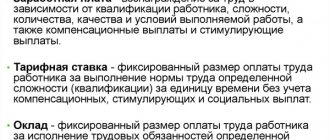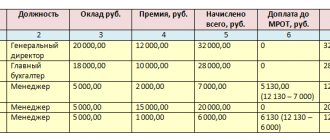Table of changes in the minimum wage value in the region
- 9489
(basic value, for all)
- 7500
(basic value, for all)
- 7350
(base value) - 5965 (for organizations funded from the federal budget)
- 6500
(base value) - 5554 (for federally funded organizations)
Note to the table: updated minimum wage values for a specific date are highlighted in bold. The values in the Astrakhan region for 2014, 2020, 2020, 2020 are given. These minimum wage values are applied in the cities of Astrakhan, Akhtubinsk, Znamensk, Kharabali, Kamyzyak and other settlements of the Astrakhan region.
About the minimum wage in the region
The Labor Code provides for the possibility of introducing a minimum wage in the region. This was done so that subjects of the Russian Federation with different economic and social development could provide citizens employed locally with a decent (or at least close to subsistence) standard of living.
How is the minimum wage set in the Russian Federation?
In accordance with the Labor Code of the Russian Federation, the salary accrued to an employee for a fully worked period at the full rate is not less than the minimum wage.
It is worth realizing that the accrued salary is not equal to the one paid out, but is 13% less than the personal income tax.
The minimum wage, in turn, is the smallest salary in the country provided for unskilled labor. The indicator is set annually by the Government by amending the Federal Law “On the Minimum Wage” of 2002. The minimum wage depends on the subsistence level and cannot be lower than it.
In the regions they pay not the minimum wage, but the minimum wage. It also depends on the cost of living (only on the regional one) and is adopted at a meeting of the regional tripartite commission on social and labor issues chaired personally by the Governor, and in some cases his deputy - the head of the Ministry of Social Development of the region. Also included: representatives of line ministries, trade union organizations and employer associations of the region.
The minimum wage by May 2020 may increase to 11.1 thousand rubles
MOSCOW, January 10. /TASS/. The Ministry of Labor will soon prepare a bill on equalizing the minimum wage (SMW) and the subsistence level from May 1, 2020; the increase in the minimum wage compared to January 2020 will be more than 17%. The ministry's press service reported this on Wednesday.
Earlier on Wednesday, Russian President Vladimir Putin, during a conversation with workers of the Tver Carriage Works, said that the minimum wage would be raised to the subsistence level earlier than planned - from May 1, 2020. The head of state emphasized that the minimum wage will be constantly indexed and will no longer fall below the subsistence level.
“A bill to increase the minimum wage to the subsistence level of the working-age population from May 1, 2020 will be prepared in the near future. From May 1, 2020, the minimum wage will be 11,163 rubles. That is, the increase in the minimum wage compared to January 2018 will be 17.5%, and the total increase in the minimum wage in 2020 will be 43%,” the press service quotes Minister Maxim Topilin as saying.
It is noted that when determining the absolute size of the minimum wage, the Ministry of Labor is guided by the cost of living of the working-age population as a whole in the Russian Federation for the second quarter of the previous year. In the second quarter of 2020, the cost of living of the working-age population was 11,163 rubles.
Minimum wage from January 1, 2020 in Russia
The Russian government has prepared a bill to increase the minimum wage. An increase in the minimum wage will affect wages, vacation pay, travel allowances and benefits for employees of companies/organizations. According to Article 1 of the minimum wage law of June 19, 2000 No. 82-FZ, from January 1, 2020, the minimum wage will correspond to the subsistence level of Russian citizens.
Decree of the Ministry of Labor and Social Protection of the Russian Federation dated August 28, 2020 No. 550 determined the living wage of the working population throughout Russia for the second quarter of 2020. The average cost of living per capita is 10,444 rubles. Living wage in the Russian Federation:
- for children – 10,390 rubles;
- for pensioners – 8,583 rubles.
Minimum wage in Astrakhan and the Astrakhan region from May 1, 2018
Articles on the topic
The minimum wage throughout Russia has already increased twice since the beginning of 2020. The last time the minimum wage increased was on May 1, 2020. Therefore, all employers in the Astrakhan region need to make sure that they pay employees no less than the established minimum wage, otherwise the company will be fined 50 thousand rubles. Find out the new minimum wage in Astrakhan and the Astrakhan region from May 1, 2020.
Salary levels in Volgograd and the region
Let's find out what the average salary is in Volgograd in 2020. The Federal Statistical Service reports that nominal average income increased by 1.2% compared to last year.
In the Volgograd region, wages vary depending on the region or urban district. The highest values are in the Kotelnikovsky district. Let's consider the values in the following urban districts, in rubles:
- in Volgograd – 34 thousand;
- in Volzhsky -33 thousand;
- in Kamyshin - 25 thousand;
- in Mikhailovka - 26 thousand;
- in Uryupinsk -23 thousand;
- in Frolovo – 22 thousand.
Salaries also differ depending on the municipal districts of the Volgograd region. In the Kotelnikovsky district, average salaries are 38 thousand rubles, in Alekseevsky - 25 thousand, in Kotovsky - 26 thousand, in the Staropoltavsky district -24 thousand, in Zhirnovsky -27 thousand, in Kamyshinsky -30 and Olkhovsky 28. Residents of Rudnyansky have the lowest income district, approximately 21 thousand.
What is the minimum wage in Astrakhan and the Astrakhan region from May 1, 2018
From May 1, the minimum wage in Astrakhan and the Astrakhan region is set for all employers at the federal level - 11,163 rubles. This is due to the amendments that were made to the law on the minimum wage by Federal Law dated 03/07/18 No. 41-FZ.
Previously, the region had a Regional Agreement between the Government of the Astrakhan Region, the Astrakhan Regional Association of Trade Union Organizations and the regional intersectoral association of employers of the Astrakhan Region on the minimum wage in the Astrakhan Region dated 05.22.14 No. 02-02-022.
The agreement established, from June 1, 2014, the minimum wage for commercial organizations in the amount of 6,500 rubles per month. For state and municipal institutions of the Astrakhan region, non-profit organizations, as well as organizations created by societies for the disabled - in the amount of the current federal minimum wage. From January 1, 2016, the minimum wage for commercial companies was increased to 7,350 rubles. The regional agreement did not apply to organizations that were financed from the federal budget, so they always relied on the federal minimum wage.
Now this regional agreement has lost force, since the regional minimum wage cannot be lower than the federal value. Therefore, the minimum salary that must be paid to an employee in Astrakhan and the Astrakhan region in 2020 from May 1 must be no lower than 11,163 rubles.
Minimum wage in Astrakhan and the Astrakhan region from May 1, 2018
— 11,163 rubles (basic value for all organizations).
Dynamics of the minimum wage in the Astrakhan region
Please also note that in some areas of the Astrakhan region, regional coefficients apply. We'll talk about this below.
What they are reading now:
Minimum wage in the Astrakhan region, taking into account regional coefficients from May 1, 2020
The Astrakhan region is equated to territories with special climatic conditions. Therefore, when paying wages to employees in some districts, regional coefficients must be taken into account. They cannot be included in the minimum wage, but must be calculated above the minimum wage. This position was taken by the Constitutional Court in its resolution dated 12/07/17 No. 38-P. That is, the salary of an employee who has worked full time must not be lower than the minimum wage, and only then should regional coefficients be applied to it.
Minimum salary in the Astrakhan region, taking into account regional coefficients from May 1, 2020
Salaries and professions
The minimum salary in Volgograd and the region is less than 15 thousand rubles. 30% of the population has this level of income. It is worth noting the professions in demand, as well as the level of salaries in these areas in rubles:
- Researchers and engineers of the highest category - 35-40 thousand.
- Business and financial sector employees – 40-45 thousand.
- Judicial staff – 80 thousand.
- Investigative Committee employees – 70 thousand.
- Prosecutor's office employees – 60 thousand.
- Teachers -25-30 thousand.
- Nurses – 18-20 thousand.
- Doctors – 25-35 thousand.
- Preschool teachers -18-20 thousand.
- Programmers – 50-80 thousand.
- Logisticians – 27-35 thousand.
- Drivers – forwarders – 35 thousand.
- Bus drivers – 25-30 thousand.
- Loaders – 20-25 thousand.
- Welders -25-40 thousand.
- Sellers -18-27 thousand.
- Utility workers - 16 thousand.
For employees of budgetary organizations, the minimum salary in the Volgograd region is 11-12 thousand.
If you look at the statistics of offers from employers, 20% of advertisements offer a salary of no more than 17 thousand rubles. Approximately half of the vacancies have salaries from 17 to 34 thousand. 15% of advertisements include offers from 35 to 65 thousand. Few employers offer salaries of more than 65 thousand and most often such advertisements are empty advertising.
How much they pay in Volgograd depends on specific enterprises. The most stable organizations in the labor market include Volgogradneftegaz, the Meteor plant, JSC Kaustik and Volgogradneftemash. At these enterprises you can find vacancies with salaries one and a half times higher than the regional average.
Industrial specialties are highly valued. One of the highest paid professions is a NAKS welder. The average salary in the Volgograd region is 50-70 thousand rubles. Argon welders and construction and installation workers earn approximately the same amount. In-demand professions include a truck crane operator, who earns up to 60 thousand rubles.
We recommend these articles:
What is the salary in Kazan?
How much do they earn in Rostov-on-Don?
What is the minimum wage
Minimum wage (minimum wage) - an established minimum wage per hour, day or month that an employer can (must) pay its employee.
The minimum wage is established by Law No. 82-FZ of June 19, 2000 “On the minimum wage”.
From January 1, 2020, the minimum wage is 11,280 rubles (Federal Law No. 421-FZ dated December 28, 2017 “On amendments to certain legislative acts of the Russian Federation regarding increasing the minimum wage to the subsistence level of the working population”).
From May 1, 2020, the minimum wage is 11,163 rubles (Federal Law No. 41-FZ dated 03/07/2018 “On amendments to certain legislative acts of the Russian Federation regarding increasing the minimum wage to the subsistence level of the working population”).
From January 1, 2018, the minimum wage is 9,489 rubles (Federal Law No. 421-FZ dated December 28, 2017 “On amendments to certain legislative acts of the Russian Federation regarding increasing the minimum wage to the subsistence level of the working population”).
From January 1, 2015, the minimum wage is 5,965 rubles (Federal Law of December 1, 2014 No. 408-FZ “On Amendments to Article 1 of the Federal Law “On the Minimum Wage”).
Since 01.01.2014, the minimum wage has been 5,554 rubles (Federal Law of 02.12.2013 N 336-FZ “On Amendments to Article 1 of the Federal Law “On the Minimum Wage”).
From January 1, 2013, the minimum wage in Russia is 5,205 rubles .
The minimum wage applies to:
wage regulation;
determining the amount of benefits for temporary disability, pregnancy and childbirth;
According to the rules set out in Article 133 of the Labor Code of the Russian Federation:
the minimum wage is established simultaneously throughout the entire territory of the Russian Federation by federal law;
is established at the expense of the employer (and in budgetary organizations - at the expense of the corresponding budget);
cannot be lower than the subsistence level of the working-age population. The legislator has allowed himself not to apply this provision for now by introducing Article 421 into the Labor Code of the Russian Federation, according to which the procedure and timing for a gradual increase in the minimum wage to the amount provided for in Art. 133 of the Labor Code, as well as the mechanism guaranteeing the payment of the minimum wage in the specified amount, are established by federal law. There is no such law yet. Consequently, the gradual increase in the minimum wage will continue until it reaches the subsistence level;
the monthly salary of an employee who has worked the standard working hours during this period and fulfilled the labor standards (job duties) cannot be lower than the minimum wage, i.e. — 5,205 rubles. It must be borne in mind that it is not the tariff rate or salary that must be compared with the minimum wage, but the entire amount of the monthly salary, taking into account compensation and incentive payments.
Subjects of the Russian Federation, Article 133.1 of the Labor Code, are given the right to establish on their territory a minimum wage that exceeds that indicated above (the so-called “minimum wage”). In this case, the establishment of a higher minimum wage is permitted by the adoption by a constituent entity of the Russian Federation of a regional agreement on the minimum wage. The meaning of such an agreement is that if such a normative act is adopted by a subject of the Russian Federation, employers operating on its territory must pay employees wages not lower than the minimum wage established by the law of the subject of the Russian Federation.
Average salaries in Volgograd by industry
The Volgograd region is a large industrial and transport center, as well as one of the regions whose economic profile can be considered balanced. In addition to industry, agriculture has developed here. In recent years, as throughout the Russian Federation, the service sector has been developing in the region.
According to Rosstat, earnings in key sectors of the economy are as follows:
- Mining - 49,754 rubles;
- Finance and insurance - 40,558 rubles;
- Construction - 30,223 rubles;
- Agriculture - 21,659 rubles;
- Professional activity - 40,334 rubles.
The Zarplata.ru portal provides more detailed statistics, based on current vacancies in the city and region;
- Energy and fuel and energy complex - 63,833 rubles;
- Trade and sales - 51,967 rubles;
- Finance and banks - 40,465 rubles;
- Construction - 66,478 rubles;
- Agriculture - 37,500 rubles.
It is worth considering, however, that informal sources like Zarplata.ru have less coverage and analyze only the data that passes through their portal.
Average salaries of public sector employees
While the leading sectors of the economy are relatively more prosperous, the average wage in Volgograd for public sector employees is one of the lowest in the country. Rosstat data:
- Teachers in secondary schools—26,676 rubles;
- Teachers in the preschool education system - 24,543 rubles;
- Teachers in the higher education system - 53,795 rubles;
- Employees of cultural institutions - 27,627 rubles;
- Social workers - 26,306 rubles;
- Doctors - 52,796 rubles.
Statics on job aggregator portals are not exhaustive: budgetary organizations often indicate the contractual salary amount, without approximate figures.
Federal minimum wage
In Russia, two minimum wages have been established:
To calculate salary and benefits
The minimum wage was used from November 29, 2002 to January 1, 2010 to regulate wages and determine the amount of temporary disability benefits .
Until November 29, 2002, it was used to regulate wages, as well as to determine the amount of benefits for temporary disability and payments in compensation for harm caused by injury, occupational disease or other damage to health associated with the performance of work duties.
from 01/01/2019
11,280 (in the amount of the subsistence level of the working-age population as a whole in the Russian Federation for the second quarter of the previous year)
Federal Law No. 421-FZ of December 28, 2017 “On amendments to certain legislative acts of the Russian Federation regarding increasing the minimum wage to the subsistence level of the working population”
from 05/01/2018
Federal Law No. 41-FZ dated 03/07/2018 “On amendments to certain legislative acts of the Russian Federation regarding increasing the minimum wage to the subsistence level of the working population”
from 01/01/2018
Federal Law No. 421-FZ of December 28, 2017 “On amendments to certain legislative acts of the Russian Federation regarding increasing the minimum wage to the subsistence level of the working population”
from 01.07.2017
Federal Law 12/19/2016 No. 460-FZ “On Amendments to Article 1 of the Federal Law “On the Minimum Wage”
from 01.07.2016
Federal Law of June 2, 2016 No. 164-FZ “On Amendments to Article 1 of the Federal Law “On the Minimum Wage”
from 01/01/2016
Federal Law of December 14, 2020 No. 376-FZ “On Amendments to Article 1 of the Federal Law “On the Minimum Wage”
from January 1, 2020
from January 1, 2014
Federal Law of December 2, 2013 N 336-FZ “On Amendments to Article 1 of the Federal Law “On the Minimum Wage”
Minimum wage for fines, taxes and penalties
The base amount used to calculate taxes, fees, fines and other payments , the amount of which, in accordance with the legislation of the Russian Federation, is determined depending on the minimum wage, as well as payments for civil obligations established depending on the minimum wage, from January 1, 2001 it is 100 rubles (Article 5 of the Law of June 19, 2000 N 82-FZ).
New minimum wage from January 1, 2020: table for all regions
According to Article 1 of the law on minimum wages (dated June 19, 2000 No. 82-FZ), from January 1, 2020, the minimum wage is fixed by federal law in the amount of the subsistence level of the working population in Russia as a whole for the second quarter of the previous year.
We recommend that you read: Deduction For Yourself 2020 Amount
Sometimes the salary may be less than the minimum wage after January 1, 2020, since the salary includes not only the salary itself, but also compensation payments (for example, various allowances for working conditions), as well as incentive payments (for example, bonuses) (Art. 129 of the Labor Code of the Russian Federation). Therefore, if in a month an employee receives, taking into account all allowances and incentives, an amount greater than or equal to the minimum wage, then this is quite normal.
Minimum salary in the regions
Many constituent entities of the Russian Federation also have a regional minimum wage.
Legislators of a constituent entity of the Russian Federation have the right to set their own minimum wage (let's call it for distinction - MW).
According to the rules of Part 3 of Article 133.1 of the Labor Code, the amount of the minimum wage for a specific subject is determined taking into account socio-economic conditions and the cost of living of the working population on its territory. Part 4 of Article 133.1. The Labor Code establishes that the minimum wage cannot be lower than the federal minimum wage.
At the moment, out of 83 constituent entities of the Russian Federation, 38 regions have introduced the minimum wage.
Who determines the regional minimum wage?
The minimum wage is established by a regional agreement of three parties (Part 6 of Article 133.1 of the Labor Code of the Russian Federation):
government of the subject (city, region, region, republic);
associations of employers (union of industrialists and entrepreneurs).
Salaries will increase from May in the Astrakhan region
From May 1, the minimum wage in Russia increases by almost 1,770 rubles, to 11,163 rubles. The increase in the minimum wage will affect 4 million people across the country, including the Astrakhan region, where the concentration of low-wage workers is one of the highest in the country. The federal center will give us money to increase the salaries of public sector employees; business must find reserves on its own.
Why exactly 11,163 rubles? According to Article 133 of the Labor Code of the Russian Federation (Labor Code of the Russian Federation), the salary of an employee who has fully worked the standard working hours for the month and fulfilled labor standards (labor duties) cannot be lower than the minimum wage. The minimum wage is established by the federal law “On the minimum wage” (No. 82-FZ of June 19, 2000, as amended and supplemented). Regions can also set their own minimum wage (in agreement with employers and trade unions), but it should not be lower than the federal one. As stated in the law, the minimum wage, in addition to regulating wages, is also used to “determine the amount of benefits for temporary disability, pregnancy and childbirth, as well as for other purposes of compulsory social insurance. The use of the minimum wage for other purposes is not permitted.” But the minimum wage is taken as the basis for calculations in the case when an employee does not have enough experience or his salary is below the minimum threshold. If everything is in order with your experience and salary, then the minimum wage will not affect the calculation of benefits. According to the same article 133 of the Labor Code of the Russian Federation, the minimum wage cannot be lower than the subsistence minimum (LM) of the working population. But for a long time it lagged behind the subsistence level, since a large number of public sector workers received and receive the minimum wage, and there was simply not enough money in the budgets (federal and regional) to raise the minimum wage to the minimum wage level in the budgets (federal and regional).
Wanted in 2020 Last year, the government of the country, on behalf of President Vladimir Putin, developed a concept to increase the minimum wage to the minimum wage level by 2020, and at the end of 2020, an amendment was made to the law on the minimum wage, stating that starting from January 1, 2020, the minimum wage salaries are set equal to the subsistence level of the working-age population as a whole in the Russian Federation for the second quarter of the previous year. At the same time, it was assumed that in 2020 the minimum wage would first be raised to 85% of the subsistence level, and from January 1 it was increased from 7,800 to 9,489 rubles. But then Vladimir Putin announced that the minimum wage should be increased to 100% of the subsistence level from May 1, 2020. Carrying out his will, the State Duma in March adopted a law on increasing the minimum wage from May 1 to 11,163 rubles - the subsistence level of the working population as a whole in the Russian Federation for the second quarter of 2020.
You need a lot of money So, from May 1 of this year, all organizations, institutions, enterprises, regardless of their form of ownership, as well as individual entrepreneurs (IP) will have to pay their employees (subject to fully worked time and fulfillment of work duties) not less than 11,163 rubles per month, and “dirty”, that is, before the deduction of income tax (NDFL), so they will receive less in their hands. If an employee works part-time or a week, then his salary and minimum wage will be calculated in proportion to the time worked. Funds to increase the minimum wage for public sector employees will be sought from budgets at the appropriate level, as well as extra-budgetary funds and money received from entrepreneurial and other income-generating activities (who have these sources of income).
The information was “classified” We tried to find out how many Astrakhan state employees are now on the “minimum wage” and how much money is needed to increase the minimum wage from May 1, but we were unable to obtain this information from the relevant structures of the regional government; for some reason they preferred to refrain from making it public . But it is known that the government will help the regions with money. The first tranche from the federal budget in the amount of 20 billion rubles has already been allocated by Order No. 440 dated March 16 of this year. Of this, the Astrakhan region will receive 129.1 million rubles in 2020. And non-state companies and individual entrepreneurs must find money to increase the minimum wage at the expense of their own capabilities. Those who have them will find them, those who don’t will come up with something, including gray salary payment schemes.










